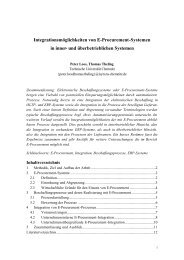Hedonic and Utilitarian Motivations of Social Network Site Adoption
Hedonic and Utilitarian Motivations of Social Network Site Adoption
Hedonic and Utilitarian Motivations of Social Network Site Adoption
You also want an ePaper? Increase the reach of your titles
YUMPU automatically turns print PDFs into web optimized ePapers that Google loves.
ehaviors that have beleaguered the confidence in these services” (Sledgianowski <strong>and</strong> Kulviwat,<br />
2008, p. 4) <strong>and</strong> confirm its influence on SNS adoption.<br />
Finally, Hu et al. (2011, p. 447) draw from psychological research <strong>and</strong> assume that ”[i]f people who<br />
are important to a person think that the person should engage in a certain activity, then the person is<br />
much more likely to engage in it” (Fishbein <strong>and</strong> Ajzen, 1975). Therefore, they also view Subjective<br />
Norm [The degree to which a persons believes “that most people who are important to him think he<br />
should or should not perform the behavior in question” (Fishbein <strong>and</strong> Ajzen, 1975, p. 302)] as an<br />
antecedent <strong>of</strong> the Behavioral Intention to Use SNSs. In their study, they confirm this relationship.<br />
3 Discussion <strong>of</strong> Current SNS <strong>Adoption</strong> Research<br />
3.1 SNSs Are Both <strong>Hedonic</strong> <strong>and</strong> <strong>Utilitarian</strong> Information Technologies<br />
Sledgianowski <strong>and</strong> Kulviwat (2008) as well as Hu et al. (2011) describe SNSs as hedonic-oriented<br />
information technologies. In contrast, Alarcón-del-Amo et al. (2012) assume that SNSs are<br />
utilitarian technologies. We believe that both views should be combined <strong>and</strong> postulate that SNSs are<br />
dual information technologies – that is, that they are both hedonic- <strong>and</strong> utilitarian-oriented.<br />
As suggested by the findings <strong>of</strong> Sledgianowski <strong>and</strong> Kulviwat (2008) as well as Hu et al. (2011) <strong>and</strong><br />
discussed multiple times by, for example, Boyd <strong>and</strong> Ellison (2007) as well as Thambusamy et al.<br />
(2010), SNS members have fun while using SNSs in general <strong>and</strong>, in particular, experience joy from<br />
the social interactions they enable. It thus appears clear that SNSs are at least partly hedonic<br />
information systems. However, other findings suggest that SNSs also fulfill utilitarian needs.<br />
Raacke <strong>and</strong> Bonds-Raacke (2008), Subrahmanyam et al. (2008) as well as Bonds-Raacke <strong>and</strong><br />
Raacke (2010) identify a broad range <strong>of</strong> SNS functionalities providing users with external benefits,<br />
such as the ability to organize events, setting reminders for friends’ birthdays, or locating old<br />
friends. Consistent with these findings, Alarcón-del-Amo et al. (2012) identify a strong influence <strong>of</strong><br />
Perceived Usefulness on the Behavioral Intention to Use SNSs.<br />
Combining these findings implies that SNSs are dual information technologies that are partly<br />
hedonic <strong>and</strong> partly utilitarian. Looking at SNSs purely from a hedonic or utilitarian perspective<br />
appears insufficient, as it would neglect significant parts <strong>of</strong> their inherent nature. In terms <strong>of</strong> the<br />
TAM, both Perceived Usefulness <strong>and</strong> Perceived Enjoyment should be included in SNS adoption<br />
studies, <strong>and</strong> both are expected to have an impact on the Behavioral Intention to Use.<br />
3.2 Perceived Usefulness Measurement Items Have to Fit SNSs’ Contexts<br />
Although we believe that SNSs are dual information technologies, current SNS adoption studies<br />
show inconsistent findings. While multiple studies confirm hedonic motivations for the use <strong>of</strong> SNSs<br />
in the form <strong>of</strong> Perceived Enjoyment, findings concerning utilitarian motivations (i.e., Perceived<br />
Usefulness) differ substantially. We credit these heterogeneous findings to the use <strong>of</strong> differing<br />
operationalization <strong>of</strong> Perceived Usefulness across studies.<br />
As discussed by Van der Heijden (2004), the classic Perceived Usefulness measurement items, such<br />
as “[u]sing [the technology] … would improve my job performance” (Davis, 1989, p. 340), focus<br />
on performance, productivity, effectiveness, etc. in a work environment. As a result, the initial<br />
work-based scale used for measuring Perceived Usefulness is inappropriate for most dual systems,<br />
<strong>and</strong> especially inappropriate for pure hedonic systems, since such systems are seldom used in work<br />
environments. Thus, researchers <strong>of</strong> hedonic <strong>and</strong> dual information technologies have to pay<br />
particular attention while constructing their Perceived Usefulness measurements, to make sure they<br />
are consistent with their specific usage contexts (Moon <strong>and</strong> Kim, 2001).<br />
6







